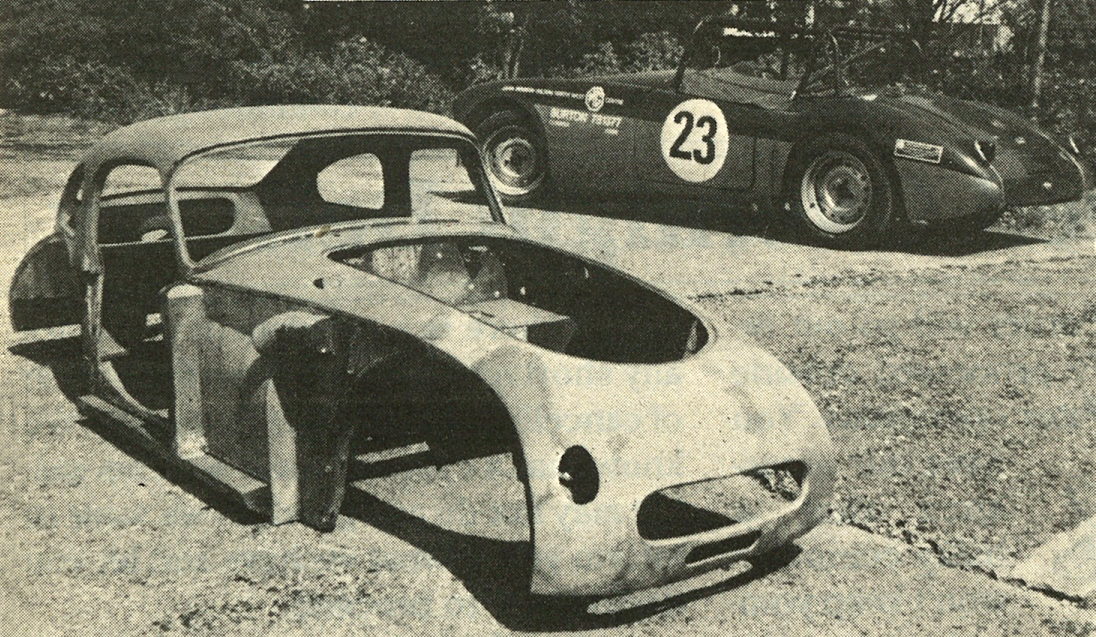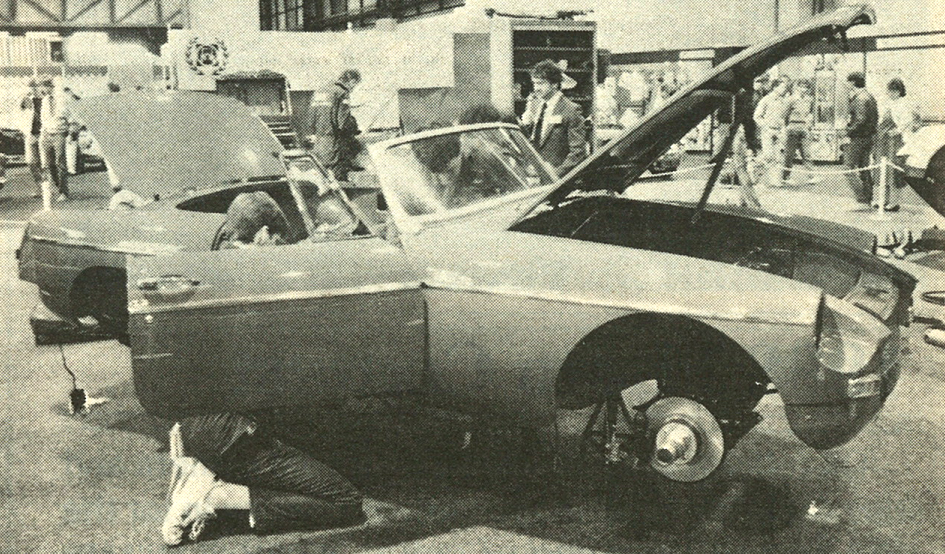From Moss Motoring Fall 1998
Maggie Mae is on the road again. After nine years of storage, Maggie, a 1957 MGA, is back where she belongs. Rousing her from her slumber and putting her back on the road proved to be almost effortless, thanks in part to a little care and forethought taken when I put her into storage. The lessons I learned while doing this may prove useful to anyone else who is forced to set their British tin aside for a few years.
 First of all, let me make it clear that I am not one to give names to cars or to regularly refer to a hunk of metal as a “her.” At a weak moment in my adolescence I named this car “Maggie” after the Rod Stewart song that was playing incessantly during the summer when I first rebuilt it. I probably haven’t used that name more than a half-dozen times since then, referring to it instead as “the MG” or occasionally as “the *%$#@% MG.” Somehow, though, it seems appropriate to use her given name on this occasion.
First of all, let me make it clear that I am not one to give names to cars or to regularly refer to a hunk of metal as a “her.” At a weak moment in my adolescence I named this car “Maggie” after the Rod Stewart song that was playing incessantly during the summer when I first rebuilt it. I probably haven’t used that name more than a half-dozen times since then, referring to it instead as “the MG” or occasionally as “the *%$#@% MG.” Somehow, though, it seems appropriate to use her given name on this occasion.
I learned about sports cars at the wheel of this beast, starting when a friend and I found it in the backyard of a run-down Indiana neighborhood and bought it for $50. It obviously hadn’t been driven for several years, rust bubbled through the multiple colors of paint that had been slapped on its bodywork, and the entire front end was smashed back about six inches. Since my friend had the only vehicle capable of towing a hulk like this, I was elected to ride in the MG steering and frantically attempting to pump up the brakes every time we stopped. I had never seen an MGA before, much less ridden in one, but I fell in love with it on that drive. My friend’s Dad ran a sports car dealership, and I soon made arrangements to buy this car. Actually, I made arrangements to buy the parts, do as much of the work as I was capable of, and do odd jobs around the shop in return for the skilled labor they put into the car. By the end of the summer the MG had a professionally rebuilt engine, an enthusiastic beginner’s body job, and a coat of the shiniest red paint money could buy.
For many years, this car was my primary transportation. It got me through college, through a year or so of working as a mechanic, and through many years of an Air Force career. My “other car” during much of this time was a 1928 Ford, so the MG was the vehicle of choice for all long distance road trips as well as routine trips to the grocery. Indiana, Michigan, Ohio, North Carolina, New York, Florida—we saw a fair chunk of territory together. In upstate New York I found they dumped more salt on the roads than Indiana or Michigan ever dreamed of, so I reluctantly began parking the MG for the winter while subjecting a series of “beaters” (starting with a $40 Chevy) to the abuse of winter driving. The MG always came out again as soon as the snows melted, and stayed on the road (top down, of course) until the November flurries brought out the salt trucks again. I did store it for about a year when I was stationed on Guam, as the tales I’d heard about the combined effects of salt air and Guam drivers made me loathe to risk the MG to that environment. (I bought a 1958 MG for this purpose instead!) Other than that, I drove the car regularly until the summer of 1988, when I got orders for Alaska. I would have loved to have driven this car along the Alaskan highway, but my wife and my two-year-old son had other ideas so I reluctantly began preparing it for its first long term storage.
 The first rule of long term storage is to make certain things are clean. Cleaning the car before you store it is essential, as dirt caked in seams, crevices, and wheel wells, tends to hold moisture and speed corrosion. Like most mechanics, I tend to emphasize function over form, and washing a car just never seems to make it to the top of the “to do” list. Finally I overcame this shortcoming by developing a five-year plan to ensure all my cars are washed regularly. The year I stored the MG happened to be the year I was scheduled to wash it anyway, so I didn’t have to do anything special in that department.
The first rule of long term storage is to make certain things are clean. Cleaning the car before you store it is essential, as dirt caked in seams, crevices, and wheel wells, tends to hold moisture and speed corrosion. Like most mechanics, I tend to emphasize function over form, and washing a car just never seems to make it to the top of the “to do” list. Finally I overcame this shortcoming by developing a five-year plan to ensure all my cars are washed regularly. The year I stored the MG happened to be the year I was scheduled to wash it anyway, so I didn’t have to do anything special in that department.
More important than outward cleanliness is cleanliness of the soul. Oil, gas, antifreeze, brake fluid—these form the heart and soul of your British car, and they’re all going to sit in your car for a long time while it’s in storage. During that time they can cause much grief if they’re dirty. I use synthetic oil in my MG engine because it’s sulphur free and doesn’t form acids after it’s gotten hot, a trait which is especially desirable if you’re going to store the car. (A friend once advised me to use synthetic oil in my gearbox as well, as he claimed the reduced friction gave him an extra horsepower or two. He was trying to race a Datsun Fairlady, which made his judgment questionable, but the fact that he occasionally caught up with the MGBs made me think he must be doing something right.) I changed the oil and filter on my MG just before putting it into storage, and at the same time I flushed the cooling system and refilled it with fresh antifreeze. (The MG manual advises one to “always use a good grade of anti-freeze solution when frosty weather is anticipated.” Since my MG was going to be stored in an unheated garage in Michigan, I could definitely anticipate frosty weather.)
I didn’t need to flush the brake and clutch fluids, because I had already switched to silicone brake fluid and didn’t need to worry about water in the system. If you’re using conventional brake fluid I would definitely recommend flushing the system and replacing it with silicone, as a little bit of water in your wheel cylinders can rust those puppies up solid after a few years storage. Rusted brake cylinders are not compatible with MG’s motto of “Safety Fast!”form the heart and soul of your British car, and they’re all going to sit in your car for a long time while it’s in storage. During that time they can cause much grief if they’re dirty. I use synthetic oil in my MG engine because it’s sulphur free and doesn’t form acids after it’s gotten hot, a trait which is especially desirable if you’re going to store the car. (A friend once advised me to use synthetic oil in my gearbox as well, as he claimed the reduced friction gave him an extra horsepower or two. He was trying to race a Datsun Fairlady, which made his judgment questionable, but the fact that he occasionally caught up with the MGBs made me think he must be doing something right.) I changed the oil and filter on my MG just before putting it into storage, and at the same time I flushed the cooling system and refilled it with fresh antifreeze. (The MG manual advises one to “always use a good grade of anti-freeze solution when frosty weather is anticipated.” Since my MG was going to be stored in an unheated garage in Michigan, I could definitely anticipate frosty weather.)
Gas poses a special problem. Unless your car is going to be stored in a climate-controlled low-humidity vault, you need to fill the tank before you store it. Otherwise, the seasonal changes in temperature will cause condensation in the tank—condensation which leads to rust. Before I bought my Model A Ford it was stored for several years with an empty tank, and I am still plagued by rust in that system. (On one of my first dates with the woman who became my wife, I was forced to disassemble the Model A fuel system and blow rust out of the fuel lines. This activity pretty much negated the effectiveness of all the careful preening I’d done before the date, to say nothing of its effect on my breath!) Even with the MG tank kept full, however, I still had problems with deposits and varnish. I made it a practice to start the MG whenever I could get home on leave (which meant once every year or two) but the starting ritual usually required disassembling the carburetors and the fuel pump to free all the moving parts that had been glued together by old gas. Fortunately, I later discovered StorN-Start in the Moss Motors catalog, a marvelous product which ended my fuel system blues.
Batteries do not like to be stored, but the situation is not as bad as some people claim. I’ve read articles that advise you to throw your battery away if the car is going to be stored for more than six months. Since I’d just bought two new Armstrong batteries from Moss the year before I stored my car, I elected not to do that. I used a battery charger to recharge the batteries at least once a year while it was in storage, and was able to still start the car reliably with nine-year-old batteries. When they turned 10 they started the car occasionally, but not reliably. I had several other cars in storage at the same time, and my experience with them was similar. It would be best if they could be charged more frequently than once a year, but an annual charging keeps them from self-destructing. It’s important to disconnect the batteries when you store a car, both for safety’s sake and to make certain nothing will run the battery down. I once neglected to do this on my E-Type, and over the winter the dashboard clock sucked the life out of my battery. No amount of charging would revive that battery, which was less than three years old, when I came home on leave the following summer.
Where you store your car is very important. I’ve tried various types of car covers and tarps and have come to the conclusion there’s no substitute for inside storage. No matter how carefully you wrap a cocoon around your car, the rain, snow, fog, and rapid temperature fluctuations are going to penetrate that cover and cause damage. Storing the car in your own garage is ideal, but I have, at various times, rented space in someone else’s garage, barn, and even an abandoned chicken coop. (Abandoned by the chickens, that is.) All gave satisfactory results. Boat owners have asimilar storage problem every winter, so ask your boat-owning friends where they store their boats, or ask a local marina about long-term storage. I’ve found several farmers who would store my cars at very reasonable rates by checking with marinas. Even if you store your car in your own garage, it’s important to protect it against mice, squirrels, spiders, and other varmints. Stuff rags up your tailpipe, your air cleaner intake, and any other hole that would make a nice home for a critter. Scatter mothballs liberally throughout the interior and trunk of your car, and hang a few moth cakes under the dash. Then cover the car with a good cloth car cover so the entire vehicle can steep in these fumes. If your car will be stored in a barn or garage with a dirt floor, you might want to lay a sheet of plastic over the car cover to keep the dirt (and chicken feathers!) from trashing your car cover. Don’t wrap the car entirely in plastic, however, as it needs to “breathe” and let condensation evaporate when the temperature changes. My experience with mothballs was that they did not keep critters out entirely (I found an incredible cache of hickory nuts under my driver’s seat) but it made them look for a more pleasant place to set up housekeeping. There were no mouse droppings or snake skins in my car, the upholstery hadn’t been torn apart for nesting materials, and even the spiders stayed clear.
My final word of advice on long-term storage is, if at all possible, start your car at least once a year. I wasn’t able to get home and start my cars every year, but I did it almost every year. Starting your car re-oils all the engine internal parts, polishes incipient corrosion off cams and other wearing surfaces before the pitting gets serious, and generally makes your car feel better. If possible, drive it around a bit (don’t leave your driveway unless it’s insured!), and give your clutch, transmission, and rear axle the same healthful exercise. Pump the brakes a few times to make certain the calipers and wheel cylinders don’t rust in peace. Due to fuel system problems I wasn’t able to start my Model A for several years, so I took out the spark plugs, squirted oil down the cylinders, and turned it over with the hand crank instead. This seemed to do the trick, as it started fine when I finally had a long enough vacation to fix the fuel system. I learned the value of turning the engine over periodically the hard way, when I stored my Model A for a few years without exercising it and then had to pull the head to free several stuck valves.
How did my MG fare after nine years of storage? The opportunity to take it out of storage came unexpectedly, so I had little time to prepare. I checked all the fluid levels, gave the batteries as much charge as they would hold, checked the lights and tum signals and jumped started it off my wife’s car. A couple of day’s driving in the local area convinced me it was ready for the trip, so I drove it from Michigan to Georgia. The drive proved to be thoroughly enjoyable, and the only unexpected event was that I got 34 mpg while more than holding my own with 70 mph Interstate traffic. A quick wash job after we got home (it was, after all, overdue according to my five-year-plan) and it was ready to drive to work the next day!
By Steve Tom







'Wake Up, Maggie!' has no comments
Be the first to comment this post!